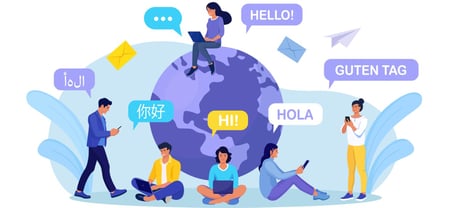
Language Service Providers (LSPs) are organizations that bridge gaps in communication. LSPs ensure that the message your company is putting out is understood correctly, both in terms of accuracy and cultural relevance. Simply put, LSPs help you reach and engage audiences, no matter where they are, which languages they speak, or what cultures they represent.
LinguaLinx knows how impactful LSPs are because we’re proud to be one. We’ve translated, localized, and interpreted over 250,000 unique projects for over 1500 clients in the past 20 years. We’ve helped countless people all around the world come together and communicate.
In this article, we’ll explain what services LSPs typically provide, who they provide them for (by location, business need, and industry), and why your organization should consider using an LSP.
What Do Language Service Providers Do?
Language Service Providers give companies expertise in meeting their audiences where they are. Regardless of where your organization is located or what languages and cultures are most familiar to your core staff, an LSP will empower you to communicate clearly with employees, clients, partners, and audiences at large. It facilitates global (and domestic) understanding.
The services provided by LSPs are broader and more complex than many people expect. Many people think language services are all about translation—but that’s far too limiting in scope.
LSPs do translate. But they also provide critical localization and interpretation services.
Translation Services: Speak Your Audience’s Language(s)
Translating is at the core of everything that LSPs do. At a base level, translation is the act of making a message legible in a new language, for new audiences. But the role translators play in business is extremely complex; they’re linguists and authors, educators, and even diplomats.
In terms of particular services LSPs provide, there are a handful of ways it takes place:
- Human Translation – An individual translator (or team thereof) carefully transforms a message into a second language, preserving all of its intended context and nuances.
- Machine Translation – Artificial intelligence (AI) uses definitions to transfer a message from one language to another, often assisted by some degree of human post-editing.
- Transcreation – Human translators work to shape a message into a second language, preserving its original intention through any necessary adaptations of its literal meaning.
- Transcription – Human translators convert spoken language into written or electronic text, in the original or another language, and in real-time or for recorded audio/video.
In addition, some LSPs offer specialized website translation services, adding a proxy translation layer that updates your website for readers in any location or language context—all in real-time.
Localization Services: Showcase Your Cultural Competency
While translation transforms a message from one language to another, it does not necessarily account for all of the cultural context and nuances of the second language. Enter localization.
Localization is closely related to translation, but it takes it a step further by focusing on:
- Minute connections between words and phrases in the target language
- Connotative differences at regional levels
- Ways in which extra-linguistic concerns (e.g., religion, history) might impact the way a message comes across.
The very best translations are usually ones that are localized.
The biggest service impacted by localization overall is website localization, a culturally sensitive approach to website translation. Localization ensures that the entire website is articulated to readers in a way that makes sense to them and actually appeals to their beliefs and values.
Some LSPs offer design localization, encompassing graphic design elements and other considerations outside of the language itself that nevertheless impacts how it is understood.
There’s also audio/video localization, which comprehensively translates audio or video content into a second language with appropriate accents and tones and culturally-informed subtitles.
Regardless of context or use case, localization maximizes uptake and buy-in for readers and listeners steeped in other cultures. It bridges would-be gaps and meets them where they’re at.
Interpretation Services: Meet All Your Communication Needs
Finally, interpretation is an area of language services that concerns spoken language almost exclusively. Interpreters typically translate language as it is spoken—in real-time—into a second spoken language or into sign language. In terms of services, LSPs often provide the following:
- Simultaneous interpretation – An individual interpreter works in real time to translate a message as it’s being spoken, in person or remote (over the phone or via video chat).
- Consecutive interpretation – An interpreter collaborates with a speaker, who pauses after each completed idea, which the interpreter translates into a different language.
- Sign language interpretation – An interpreter works simultaneously or consecutively to translate speech into American Sign Language (ASL) or international sign languages.
Interpretation services ensure audience members who speak a different language than your speakers, or are deaf or hard of hearing, can understand a speech along with other listeners.
Who Needs Language Service Providers Most?
Language Services are applicable all over the world, for every kind of organization and at every level. If you’re trying to reach diverse audiences, you’ll likely benefit greatly from working with an LSP.
In terms of location, organizations based in or serving North America and Europe tend to use LSPs the most. As recently as 2019, Europe commanded 46.51% of LSPs’ global market share, while North America used 40.24%. Asia accounted for about 13% of global LSP usage, whereas South America and Africa accounted for less than 1% each (0.22% and 0.05%, respectively).
However, the locations served do not necessarily reflect the languages (or services) needed.
Over one billion people worldwide speak Mandarin Chinese, including nearly 900 million native speakers. Likewise, over 500 million people speak Spanish, including over 460 million native speakers. Despite the smaller market shares of Asia and South America, any business targeting these audiences needs to account for translation, localization, and interpretation.
Outside of regional specificity, other key factors in determining LSP applicability are industry and business model—LSPs meet both B2C and B2B needs, in every industry, but in different ways.
How Language Service Providers Meet B2C and B2B Needs
Working with an LSP helps organizations communicate more clearly with all audiences, existing and potential. Simply put, whether you’re talking to end-consumers or other businesses, you’ll need to account for differences in language and culture across all of your messaging.
In the business-to-consumer (B2C) market, English has the most availability across websites and applications. But the vast majority of people (80%) prefer making purchases when a website uses their native language. In fact, 72% of people will only buy products sold in their mother tongue, and 74% are more likely to make repeat purchases when cared for in their own language.
In the business-to-business (B2B) space, concerns center around globalized workforces’ English language competency. Many companies rely on heavily technical documentation, which is often translated but not localized. Technical support is critical. To be effective, it needs to anticipate and accommodate differences in language as well as values and assumptions.
These needs exist no matter where you’re located—or what industry you work within.
Industries That Need Language Service Providers Most
Here are some of the industries and sectors that need language services the most (and why):
- Travel and tourism, to attract global communities to new countries and regions.
- Education and eLearning, to facilitate multicultural student learning and staff training.
- Retail and consumer goods, to satisfy customers across regional and national borders.
- Manufacturing and engineering, to ensure clear and accurate technical specifications.
- Marketing and advertising, to reach global markets—and more buyers in domestic ones.
- Human Resources and Legal, to ensure fair treatment and representation for all staff.
- Technology and software, to increase user bases for software and niches like gaming.
- Healthcare and medical, to ensure equitable access to care across cultural boundaries.
- Banking and financial services, to meet regulatory demands for accuracy and reporting.
- Government and non-profits, to meet Title VI and other requirements, as well as the special needs of government-aligned industries (i.e., Defense Industry regulations).
LSPs are used at all levels in both the private and public sectors. For example, in 2022, the White House hired full-time American Sign Language (ASL) Interpreters for the first time in its history.
No matter your location, business model, or industry, you could benefit from an LSP.
Why You Should Use a Language Service Provider
Choosing an LSP to work with is no quick decision.
At a basic level, using an LSP streamlines communication across various global audiences. You can reach more readers and listeners, and get your message across to them more clearly and accurately—ultimately leading to greater brand recognition, quality leads, and sales.
But another critical reason many businesses use LSPs is to meet legal requirements related to government funding, accessibility, and other applicable regulations. Common examples include:
- Title VI of the Civil Rights Act – If your organization receives federal funding, it cannot discriminate against individuals based on national origin; protections extend to Limited English Proficiency (LEP) individuals, who must be guaranteed “meaningful access.”
- Americans With Disabilities Act (ADA) – Government and business entities are required to provide “Effective Communication” that meets the needs of people with disabilities.
Failure to meet either standard’s requirements could result in financial or legal consequences.
So, if either of these laws applies to you, or if your organization wants to reach and engage a broader audience, you would likely benefit from working with a quality LSP—like LinguaLinx.
Unlock the Power of Language Service Providers
Pondering the impact of language service providers? Dive into a conversation with us to learn more.
Engage in a free consultation, with absolutely no strings attached.
With LinguaLinx, you're not just getting a service provider; you're partnering with a team backed by ISO 17100 and ISO 9001 certifications, 20 years of industry experience, and the confidence of countless organizations we've collaborated with. Discover the difference of a trusted language partner.






